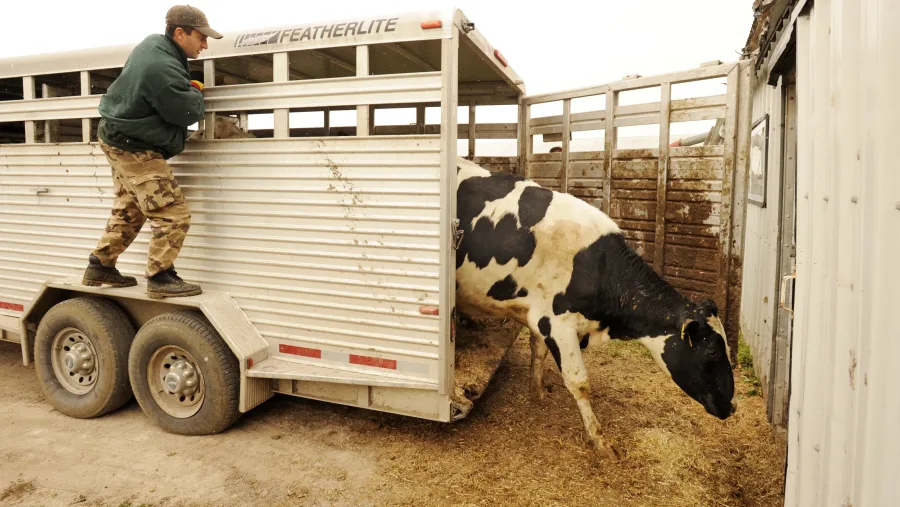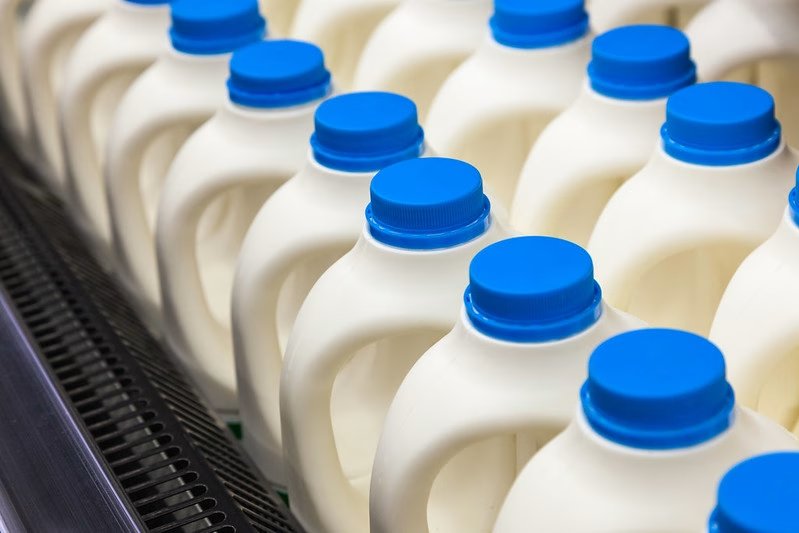Uncover the ways farm practices might be contributing to the bird flu spread among U.S. dairy cattle. Are shared transportation and labor amplifying the risk? Find out more.

The emergence of highly Pathogenic Avian Influenza (HPAI) in U.S. dairy cattle has sparked significant concerns. Since June 21, the U.S. Department of Agriculture (USDA) has reported the virus in dairy cows in 12 states, underscoring the urgent need for immediate action to prevent disruption in the food supply chain and dairy output.
Julie Gauthier of the USDA underlined the challenge of precisely determining transmission paths. The poll conducted by the USDA revealed:
- 51% of dairy farms used shared trucks or trailers for cattle.
- 50-85% reported frequent visitors with direct cattle contact.
- 27% received new cattle within 30 days before symptoms appeared.
“We can’t say this is exactly how the virus made its way onto the premises, but we can look at those risky activities that are happening on-farm to get an idea of how this might be spreading around,” said Gauthier during a June 24 webinar.
The effects on the dairy sector are significant. Ongoing viral transmission may lower milk output and call for strict biosecurity policies. To handle this problem, the USDA is deploying epidemiological strike squads. These squads, comprised of disease control and prevention experts, will conduct thorough investigations to identify the source of the outbreak and implement immediate control measures.
Cross-Species Threat: Bird Flu’s Unprecedented Impact on Dairy Cattle
Avian influenza—also known as bird flu—is a highly infectious virus that primarily affects natural hosts and wild birds such as ducks and geese. Chickens and turkeys are among the poultry that are vulnerable and usually die fast from the infection. Direct contact with sick birds or polluted surroundings—including water, food, and tools—helps to transmit bird flu.
The finding of avian influenza in dairy cattle is unusual and concerning. Since dairy cows are not shared hosts for this virus, a broader, more forceful spread is indicated. This implies that the virus may adapt or benefit from agricultural methods to enable its transgression across species.
This cross-species transmission has far-reaching implications for public health and milk output. Reduced milk production from infected cows impacts dairy companies’ production, while the potential for the virus to infect mammals, including humans, increases the risk of a pandemic. This underscores the critical need for immediate, coordinated action to address this evolving threat.
The presence of avian influenza in cattle necessitates the implementation of rigorous biosecurity policies and surveillance to prevent its further spread and protect public health and agriculture. Coordinated actions are essential to effectively manage this evolving threat and balance immediate needs with long-term strategies.
The Interconnected Web of Farm Practices: A Challenge in Controlling Bird Flu Spread Among Dairy Cattle
The linked network of agricultural activities seriously hampered controlling bird flu transmission in dairy cattle. One crucial risk element is the joint usage of trailers and vehicles, commonly called ‘shared transportation. ‘ With just half likely cleansed before reuse, the USDA discovered that 51 percent of farms utilized shared transportation, providing a risky conduit for the virus to move.
Frequent farm visits increase the danger; 50 to 85 percent of them often contact with animals. These guests can unintentionally infect many farms with the pathogen.
Shared staff across dairies and even poultry farms raises another issue. Strict biosecurity rules are desperately needed, as workers traveling between farms may readily spread the virus via contaminated hands, shoes, and clothes.
Curbing the virus’s spread and safeguarding health depends on addressing these hazards through improved biosecurity policies, cleaning procedures, and the follow-through of the Secure Milk Supply Plan. This plan, developed by the USDA, outlines specific biosecurity measures and response protocols to be followed in the event of a disease outbreak, thereby helping to protect the health of dairy cattle and the safety of the milk supply.
Decoding the Spread: USDA Survey Highlights Key Risk Factors in Dairy Bird Flu Transmission
The USDA’s study emphasizes essential elements in the spread of avian flu among dairy cows. Significantly, 50–85% of farms have regular visits with livestock interaction, and 51% exchange vehicles or trailers. Furthermore, 27% of farmers had acquired cattle within 30 days after the appearance of clinical symptoms. By transmitting the virus on hands, clothes, and shoes, shared workers traveling between dairy farms and poultry houses create a significant danger. These methods highlight how urgently strong biosecurity policies are needed.
Critical Need for Robust Biosecurity and Vigilant Monitoring in Combating Bird Flu
Julie Gauthier stressed throughout the webinar the importance of solid biosecurity and constant surveillance. “Identifying and reducing risk factors is utmost,” she said.
Gauthier said shared transportation and people interaction between farms were vital issues. She pushed farm managers toward strict cleanliness standards. “To stop transmission, vehicles have to be completely cleaned and sterilized,” she said.
Dr. Emily Johnson of the Council for Agricultural Science and Technology repeated Gauthier’s observations on worker management. “Shared laborers traveling between fields represent a major hazard. Employees must strictly follow guidelines like cleaning shoes and changing clothes,” Johnson said.
Gauthier further underlined the need for fast reporting and monitoring. “Our strongest protection is early identification, accomplished by regular testing and observation. We have to document any suspicious instances right now,” she said.
She underlined USDA’s new voluntary herd status program, which promotes frequent testing to guarantee herds stay free from contamination. “We want to find sick animals and keep cattle moving safer,” she said.
The experts agreed that controlling the epidemic depends on knowledge of linked agricultural practices, improvement of biosecurity, and careful monitoring. “Every action we take now to lower these hazards helps to protect our food supply chain,” Gauthier said.
Proactive Measures and Financial Support: USDA’s Strategy to Mitigate Bird Flu Outbreaks in Dairy Cattle
With ramped-up testing, the USDA expects to uncover more highly pathogenic avian influenza (HPAI) infections in dairy cows. This phase is crucial for controlling the spread and safeguarding the dairy sector. The agency’s epidemiology “strike teams” will enable speedier reactions by using thorough interviews and testing to uncover latent cases.
A vital component of this initiative is the government’s financial relief program, which pays for up to 90% of lost milk output brought on by HPAI. This helps motivate dairy farmers to follow rigorous biosecurity policies and complete testing. The USDA wants to stop the present epidemic and others by tying health procedures with financial help.
The Bottom Line
The bird flu outbreak in American dairy cows has exposed many dangerous farming methods, including shared transportation, frequent visits, and staff mobility. These activities need further attention, even if particular transmission routes are unknown. Focusing on monitoring, testing, and minimizing cow movement, Julie Gauthier of the USDA underlines robust biosecurity policies, including those in the Secure Milk Supply Plan.
Dairy farmers should be educated about possible hazards and use rigorous biosecurity procedures. Maintaining herd health and production depends on frequent testing and reporting, so the USDA’s voluntary herd status program supports these activities.
Protecting the dairy sector against avian influenza depends on a commitment to exacting biosecurity and group efforts. Vigilance and follow-through with advised procedures are also crucial for maintaining vital dairy operations and stopping the spread of the virus.
Key Takeaways:
- Shared Transport Woes: Over half of the surveyed farms (51%) used trucks or trailers shared with other farms to move cattle, significantly elevating the risk of viral transmission.
- Human Vectors: Frequent visitors and shared workers, often transiting between dairy and poultry premises, have been identified as significant contributors to the spread of the virus.
- Interstate Movement of Cattle: 27% of producers reported receiving new cattle within 30 days prior to the detection of flu symptoms, highlighting the risk associated with interstate livestock movement.
- Biosecurity Imperative: Gauthier emphasizes the critical need for robust biosecurity measures, as outlined in the Secure Milk Supply Plan, to mitigate the spread of HPAI.
- Herd Status Program: The USDA has introduced a voluntary herd status program, requiring weekly testing of cattle and bulk tank milk, to allow for safer movement of livestock while maintaining low infection rates.
- Future Outlook: The USDA anticipates additional HPAI cases in dairy cattle as enhanced testing continues, urging producers to engage in proactive measures and leverage financial aid programs to manage potential impacts.
Summary:
The highly Pathogenic Avian Influenza (HPAI) has been reported in 12 US states since June 21, with 51% of dairy farms using shared trucks or trailers for cattle. This poses a significant threat to the dairy sector, as ongoing viral transmission may lower milk output and necessitate strict biosecurity policies. The interconnected web of farm practices has hampered controlling bird flu transmission in dairy cattle. The joint usage of trailers and vehicles, known as “shared transportation,” increases the danger, as frequent farm visits can unintentionally infect many farms with the pathogen. Shared staff across dairies and poultry farms also raises another issue, as workers traveling between farms may easily spread the virus via contaminated hands, shoes, and clothes. To curb the virus’s spread and safeguard health, improved biosecurity policies, cleaning procedures, and the Secure Milk Supply Plan are needed. The USDA’s voluntary herd status program promotes frequent testing to ensure herds remain free from contamination. Controlling the epidemic depends on knowledge of linked agricultural practices, improvement of biosecurity, and careful monitoring.













